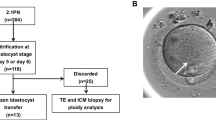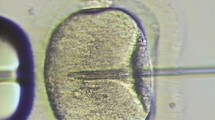Summary
Purpose
To evaluate the proportions of abnormal and normal embryos detected by preimplantation genetic diagnosis (PGD) of infertile couples of whom one was a Robertsonian translocation (RT) carrier, and to provide practical information, including details of reproductive outcomes, to aid in genetic counseling of such couples.
Methods
We retrospectively analyzed all PGD cycles conducted to deal with RT at our center between January 2000 and December 2009. Subject demographic and clinical data were compared with the results of PGD.
Results
Employing PGD, we conducted a total of 66 cycles on 34 couples of whom one was an RT carrier, including 24 female and 10 male carriers. Of the 514 blastomeres tested, 161 (31.3%) were normal or balanced. Of the 57 cycles that included embryo transfer, 17 (29.8%) attained positivity for human chorionic gonadotropin (hCG). A total of 17 embryos were implanted and 16 babies, including two sets of twins, were born. The takehome baby rate was 41.2% per couple and the loss rate 6.6%. Receiver operating characteristic curve analysis showed that the proportion of alternate embryos associated with a sensitivity of 70.6% for prediction of clinical pregnancy following PGD was 0.31. Sex of the carrier and type of translocation were not significantly associated with pregnancy outcomes.
Conclusion
Couples with RT may benefit from PGD; pregnancy success rate is improved and embryo loss reduced. We found that about 30% of embryos were of normal or balanced chromosomal constitution and that the percentage of normal or balanced embryos was predictive of PGD outcome.

Similar content being viewed by others
References
Fryns J-P, Van Buggenhout G. Structural chromosome rearrangements in couples with recurrent fetal wastage. Eur J Obstet Gynecol Reprod Bio. 1998;81:171–6.
Nielsen J, Wohlert M. Chromosome abnormalities found among 34,910 newborn children: results from a 13-year incidence study in Arhus, Denmark. Hum Genet. 1991;87:81–3.
Therman E, Susman B, Denniston C. The nonrandom participation of human acrocentric chromosomes in Robertsonian translocations. Ann Hum Genet. 1989;53:49–65.
Guttenbach M, Engel W, Schmid M. Analysis of structural and numerical chromosome abnormalities in sperm of normal men and carriers of constitutional chromosome aberrations. A review Hum Genet. 1997;100:1–21.
Munne S, Sandalinas M, Escudero T, Fung J, Gianaroli L, Cohen J. Outcome of preimplantation genetic diagnosis of translocations. Fertil Steril. 2000;73:1209–18.
Munne S, Scott R, Sable D, Cohen J. First pregnancies after preconception diagnosis of translocations of maternal origin. Fertil Steril. 1998;69:675–81.
Tharapel AT, Tharapel SA, Bannerman RM. Recurrent pregnancy losses and parental chromosome abnormalities: a review. BJOG. 1985;92:899–914.
Conn CM, Harper JC, Winston RM, Delhanty JD. Infertile couples with Robertsonian translocations: preimplantation genetic analysis of embryos reveals chaotic cleavage divisions. Hum Genet. 1998;102:117–23.
Emiliani S, Gonzalez-Merino E, Van den Bergh M, Abramowicz M, Englert Y. Higher degree of chromosome mosaicism in preimplantation embryos from carriers of robertsonian translocation t(13:14). J Assist Reprod Genet. 2003;20:95–100.
Scriven PN, Flinter FA, Braude PR, Ogilvie CM. Robertsonian translocations–reproductive risks and indications for preimplantation genetic diagnosis. Hum Reprod. 2001;16:2267–73.
Munne S, Cohen J. Chromosome abnormalities in human embryos. Hum Reprod Update. 1998;4:842–55.
Coonen E, Dumoulin JC, Ramaekers FC, Hopman AH. Optimal preparation of preimplantation embryo interphase nuclei for analysis by fluorescence in-situ hybridization. Hum Reprod. 1994;9:533–7.
Verlinsky Y, Tur-Kaspa I, Cieslak J, Bernal A, Morris R, Taranissi M, et al. Preimplantation testing for chromosomal disorders improves reproductive outcome of poor-prognosis patients. Reprod Biomed Online. 2005;11:219–25.
Otani T, Roche M, Mizuike M, Colls P, Escudero T, Munne S. Preimplantation genetic diagnosis significantly improves the pregnancy outcome of translocation carriers with a history of recurrent miscarriage and unsuccessful pregnancies. Reprod Biomed Online. 2006;13:869–74.
Sermon KD, Michiels A, Harton G, Moutou C, Repping S, Scriven PN, et al. ESHRE PGD Consortium data collection VI: cycles from January to December 2003 with pregnancy follow-up to October 2004. Hum Reprod. 2007;22:323–36.
Munne S, Escudero T, Sandalinas M, Sable D, Cohen J. Gamete segregation in female carriers of Robertsonian translocations. Cytogenet Cell Genet. 2000;90:303–8.
Stephenson MD, Sierra S. Reproductive outcomes in recurrent pregnancy loss associated with a parental carrier of a structural chromosome rearrangement. Hum Reprod. 2006;21:1076–82.
Carp HJ, Dirnfeld M, Dor J, Grudzinskas JG. ART in recurrent miscarriage: preimplantation genetic diagnosis/screening or surrogacy? Hum Reprod. 2004;19:1502–5.
Sugiura-Ogasawara M, Ozaki Y, Sato T, Suzumori N, Suzumori K. Poor prognosis of recurrent aborters with either maternal or paternal reciprocal translocations. Fertil Steril. 2004;81:367–73.
Franssen MT, Korevaar JC, van der Veen F, Leschot NJ, Bossuyt PM, Goddijn M. Reproductive outcome after chromosome analysis in couples with two or more miscarriages: index [corrected]-control study. BMJ. 2006;332:759–63.
Verlinsky Y, Cieslak J, Evsikov S, Galat V, Kuliev A. Nuclear transfer for full karyotyping and preimplantation diagnosis for translocations. Reprod Biomed Online. 2002;5:300–5.
Escudero T, Abdelhadi I, Sandalinas M, Munne S. Predictive value of sperm fluorescence in situ hybridization analysis on the outcome of preimplantation genetic diagnosis for translocations. Fertil Steril. 2003;79:1528–34.
Escudero T, Lee M, Carrel D, Blanco J, Munne S. Analysis of chromosome abnormalities in sperm and embryos from two 45, XY, t(13:14). Prenat Diag. 2000;20:599–602.
Engels H, Eggermann T, Caliebe A, Jelska A, Schubert R, Schüler HM, et al. Genetic counseling in Robertsonian translocations der(13;14): frequencies of reproductive outcomes and infertility in 101 pedigrees. Am J Med Genet Part A. 2008;146A:2611–6.
Ogur G, Van Assche E, Vegetti W, Verheyen G, Tournaye H, Bonduelle M, et al. Chromosomal segregation in spermatozoa of 14 Robertsonian translocation carriers. Mol Hum Reprod. 2006;12:209–15.
Anahory T, Hamamah S, Andreo B, Hedon B, Claustres M, Sarda P, et al. Sperm segregation analysis of a (13;22) Robertsonian translocation carrier by FISH: a comparison of locus-specific probe and whole chromosome painting. Hum Reprod. 2005;20:1850–4.
Munne S. Analysis of chromosome segregation during preimplantation genetic diagnosis in both male and female translocation heterozygotes. Cytogenet Genome Res. 2005;111:305–9.
Jin H, Ping L, Jie Q, Ying L, Yongjian C. Translocation chromosome karyotypes of the Robertsonian translocation carriers' embryos. Fertil Steril. 2009;93:1061–5.
Evsikov S, Cieslak J, Verlinsky Y. Effect of chromosomal translocations on the development of preimplantation human embryos in vitro. Fertil Steril. 2000;74:672–7.
Huang J, Lian Y, Qiao J, Chen Y, Ren X, Liu P. Characteristics of embryo development in Robertsonian translocations' preimplantation genetic diagnosis cycles. Prenat Diagn. 2009;29:1167–70.
Gianaroli L, Magli MC, Ferraretti AP, Munne S, Balicchia B, Escudero T, et al. A Possible interchromosomal effect in embryos generated by gametes from translocation carriers. Hum Reprod. 2002;17:3201–7.
Kyu Lim C, Hyun Jun J, Mi Min D, Lee HS, Young Kim J, Koong MK, et al. Efficacy and clinical outcome of preimplantation genetic diagnosis using FISH for couples of reciprocal and Robertsonian translocations: the Korean experience. Prenat Diagn. 2004;24:556–61.
Fischer J, Colls P, Escudero T, Munne S. Preimplantation genetic diagnosis (PGD) improves pregnancy outcome for translocation carriers with a history of recurrent losses. Fertil Steril. 2009;94:283–9.
Goddijn M, Joosten JH, Knegt AC, VanderVeen F, Franssen MT, Bonsel GJ, et al. Clinical relevance of diagnosing structural chromosome abnormalities in couples with repeated miscarriage. Hum Reprod. 2004;19:1013–7.
Acknowledgments
This study was supported by a grant (no. A084923) from the Korea Healthcare Technology R&D Project, Ministry for Health, Welfare and Family Affairs, Republic of Korea.
This work was presented, in part, at the 64th Annual Meeting of the American Society for Reproductive Medicine, San Francisco, CA, on November 8, 2008.
Author information
Authors and Affiliations
Corresponding author
Additional information
Capsule Couples with RT may have benefit from PGD by improving success rate of pregnancy with reducing loss and ratio of normal or balance embryo has value in predicting PGD outcome.
Rights and permissions
About this article
Cite this article
Chang, E.M., Han, J.E., Kwak, I.P. et al. Preimplantation genetic diagnosis for couples with a Robertsonian translocation: practical information for genetic counseling. J Assist Reprod Genet 29, 67–75 (2012). https://doi.org/10.1007/s10815-011-9654-1
Received:
Accepted:
Published:
Issue Date:
DOI: https://doi.org/10.1007/s10815-011-9654-1




